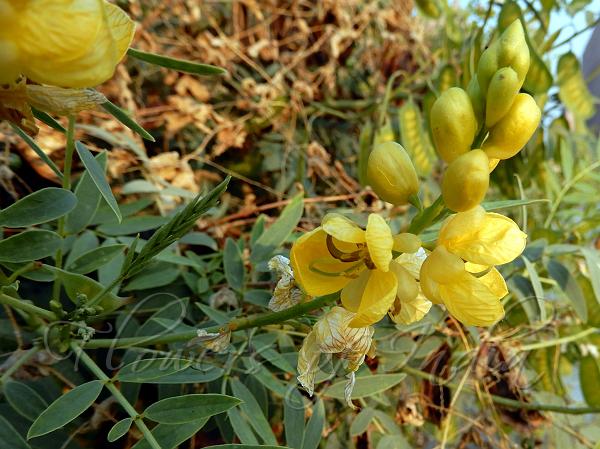|
| Indian Senna |
|

|

| File size | 666968 |
| Original date | 12/10/19 6:00 PM |
| Resolution | 2048 x 1536 |
| Flash | Flash did not fire, auto |
| Focal length | 4.3mm |
| Exposure time | 1/250s |
| Aperture | 3.4 |
| Focus Distance | |
| Metering Mode | Center weighted average |
| Camera make | NIKON |
| Camera model | COOLPIX A900 |
| Sensor type |
|
|
|
|
Photo: |
Botanical name: Senna alexandrina Family: Caesalpiniaceae (Gulmohar family)
Synonyms: Cassia acutifolia, Cassia senna, Senna angustifolia, Cassia angustifolia
Synonyms: Cassia acutifolia, Cassia senna, Senna angustifolia, Cassia angustifolia
Indian Senna is a woody perennial herb, up to 3 ft
tall. Flowers are borne in raceme, up to 15 cm long, at branch ends or
in leaf axils. Young flowers are covered with about 7-8 mm long
cup-shaped bracts. Flower-stalks are 3-4 cm long, sepals 5, nearly
equal, 1.0-1.3 cm long, about 6-8 mm broad, spoon shaped or cup shaped,
light yellow in colour. Petals are 5, nearly equal, 1.4-1.7 cm long,
7-10 mm wide, obovate, shortly clawed, deep yellow, veins becoming
prominent after drying. Stamens are 10, upper 3 reduced to staminodes,
rest perfect, 2 lower largest. Ovary is densely hairy, stipitate.
Branches are hairless to nearly so. Stipules are lateral, about 1.5 mm
long, pointed. Leaves are compound, about 4.5-11.5 cm long, 5-9 pairs
of narrow lanceshaped to ovate leaflets, about 1.2-4 cm long, 3.5-10 mm
wide. Pods are about 4-5 cm long, about 1.6-2.2 cm broad, sparsely
hairy, turning black at maturity, generally 4-10 seeded; stipe 2-3 mm.
Indian Senna is found in Sahara & Sahel to the Indian Subcontinent.
Flowering: All year.
Medicinal uses: Historically, Senna
alexandrina was used in the form of senna pods, or as herbal tea made
from the leaves, as a laxative. Modern medicine has used extracts since
at least the 1950s as a laxative. If accidentally ingested by infants,
it can cause side effects such as severe diaper rash. The active
ingredients are several senna glycosides which interact with immune
cells in the colon.
Historically, Senna
alexandrina was used in the form of senna pods, or as herbal tea made
from the leaves, as a laxative. Modern medicine has used extracts since
at least the 1950s as a laxative. If accidentally ingested by infants,
it can cause side effects such as severe diaper rash. The active
ingredients are several senna glycosides which interact with immune
cells in the colon.
Medicinal uses:
 Historically, Senna
alexandrina was used in the form of senna pods, or as herbal tea made
from the leaves, as a laxative. Modern medicine has used extracts since
at least the 1950s as a laxative. If accidentally ingested by infants,
it can cause side effects such as severe diaper rash. The active
ingredients are several senna glycosides which interact with immune
cells in the colon.
Historically, Senna
alexandrina was used in the form of senna pods, or as herbal tea made
from the leaves, as a laxative. Modern medicine has used extracts since
at least the 1950s as a laxative. If accidentally ingested by infants,
it can cause side effects such as severe diaper rash. The active
ingredients are several senna glycosides which interact with immune
cells in the colon. | Identification credit: S. Kasim | Photographed in IIT Campus, Jodhpur, Rajasthan. |
• Is this flower misidentified? If yes,